32. Change in nutrients in the intestines
Digestion in the duodenum. In the small intestine, the breakdown of nutrients that are contained in the food gruel that enters the intestine from the stomach continues. Wavy contractions of the intestinal walls (Fig. 98) gradually move the food slurry through the intestines. Very important processes of splitting proteins, fats and carbohydrates occur in the first section of the intestine - the duodenum, where, as you know, the excretory ducts of the liver and pancreas flow.
The liver is a vital organ with a variety of functions. It is the largest gland in our body. The liver occupies a significant part of the right side of the abdominal cavity (color. Table IV, 6).
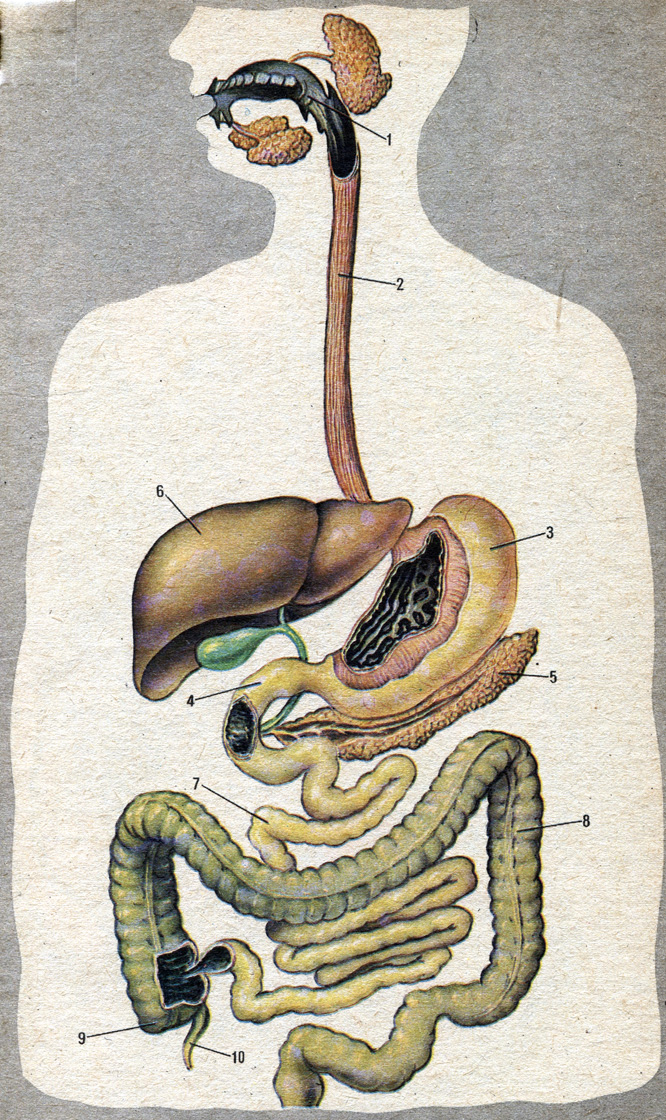
The liver produces bile, which is secreted through the bile duct (Fig. 99, 1) into the duodenum. Excess bile is collected in the gallbladder (2) and can be used when there is increased digestion in the duodenum.
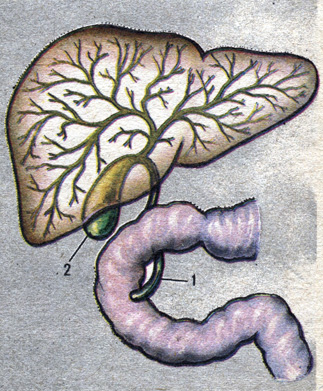
Bile does not break down the nutrients of food, but thanks to its action, the digestion of fats is facilitated. Under the influence of bile, they break up into a huge number of tiny droplets. Therefore, fats are more easily broken down by the enzymes of the digestive juices secreted by the pancreas and the small glands of the small intestine.
Some of the other functions of the liver will be discussed later.
Frequent use of alcoholic beverages often causes dangerous liver diseases. In alcoholics, there is a gradual degeneration of liver tissue and its replacement with fatty tissue. Such a disease leads to severe consequences for the body and often ends in death.
The pancreas (Fig. 100, color. Table IV, 5) secretes pancreatic juice into the duodenum through two ducts. The activity of the pancreas has long remained a mystery to scientists. They could not manage to put a fistula on her.

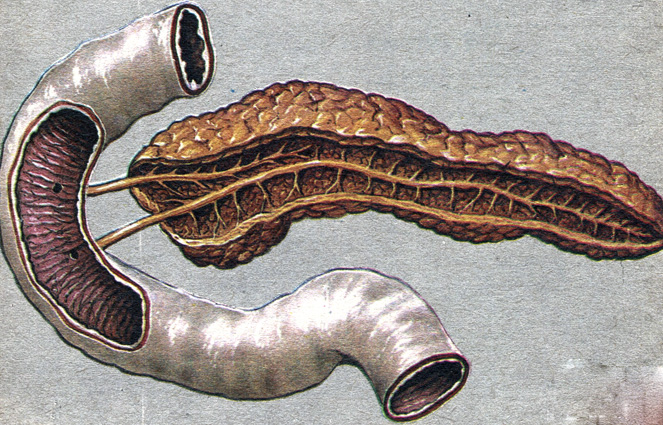
The honor of solving this difficult problem belongs to IP Pavlov, who developed the operation of removing one of the two pancreatic ducts to the surface of the dog's abdomen. The second duct remained intact, and through it the pancreatic juice was secreted into the duodenum. Therefore, the processes of digestion in it were not disturbed.
Such an operation helped the scientist to find out the functions of the pancreas and the causes that cause the separation of pancreatic juice.
Digestion in the duodenum occurs under the influence of pancreatic juice. The enzymes of this juice act on all nutrient organic compounds. Under the influence of one of these enzymes, the breakdown of proteins that began in the stomach to the formation of water-soluble amino acids is basically completed. Under the action of another enzyme, fats are broken down into glycerol and fatty acids. In the presence of a number of pancreatic enzymes, starch that has not been digested by saliva is broken down into glucose molecules.
Pancreatic enzymes work only in the alkaline environment created by bile at our body temperature.
Digestion in the rest of the small intestine. The length of the small intestine is 3-4 times the height of a person. In its mucous membrane there is a huge number of tiny glands. Passing through the small intestine, the food slurry irritates the glands, and they secrete intestinal juice. Under the action of intestinal juice enzymes, the breakdown of proteins, fats and carbohydrates that have not had time to be digested in the previous sections of the alimentary canal is completed.
Thus, the content of the small intestine contains water-soluble amino acids, glycerol, fatty acids, and glucose. The Soviet scientist A. M. Ugolev established that the breakdown of nutrients in the small intestine is most intense on its inner surface, completely covered with microscopic outgrowths - villi. Such a surface absorbs a large number of enzymes, forming a kind of porous catalyst, on which the processes of enzymatic cleavage of a number of substances take place. Such digestion is called parietal.
Absorption into the blood of the breakdown products of nutrients. In the sections of the small intestine, following the duodenum, the products of the breakdown of proteins, fats and carbohydrates are absorbed into the blood. How does this process take place?
The entire inner surface of the small intestine, when viewed with the naked eye, seems velvety (color. Table V). Under the microscope, it can be seen that there are many villi on the mucous membrane of the small intestine (1). Their huge number (2500 villi per 1 cm 2) significantly increases the suction surface of the mucous membrane of the small intestine. The walls of the villi consist of a single-layered epithelium (2). A blood vessel (3) enters each villus, forming a capillary network in it. In addition, small lymphatic vessels originate in the villi (4).
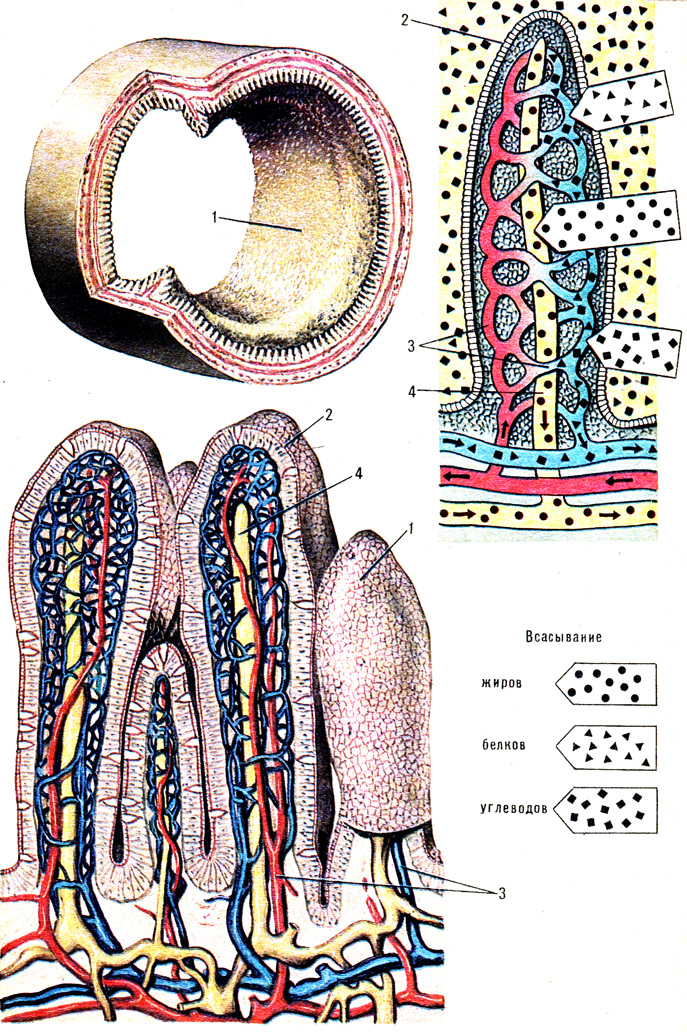
Amino acids and glucose dissolved in water are absorbed into the blood flowing through the capillaries of the villi. Glycerol and fatty acids penetrate into the epithelial cells of the villi. This is where the formation of fats characteristic of the human body occurs. In the form of tiny droplets, fats enter the lymphatic vessels and, together with the lymph, enter the bloodstream. An excess amount of fat is deposited in the form of a reserve in the subcutaneous adipose tissue, omentum and in some other places of the body.
Previously, it was believed that absorption is the filtration of cleavage products dissolved in water through the walls of the villi. Experiments disproved this assumption. The scientists killed the cells of the mucous membrane of the small intestine of animals with some poisons, as a result of which the absorption stopped. Thus, it was proved that absorption is a complex process carried out by the cells of the villi.
Barrier role of the liver. All blood flowing from the intestines (color table VI, 1) passes through the liver (2). Some harmful or poisonous substances that can enter the intestines in small quantities with food are absorbed through the villi into the blood. These substances are retained in the liver. Here they are neutralized and excreted along with bile through the intestines.
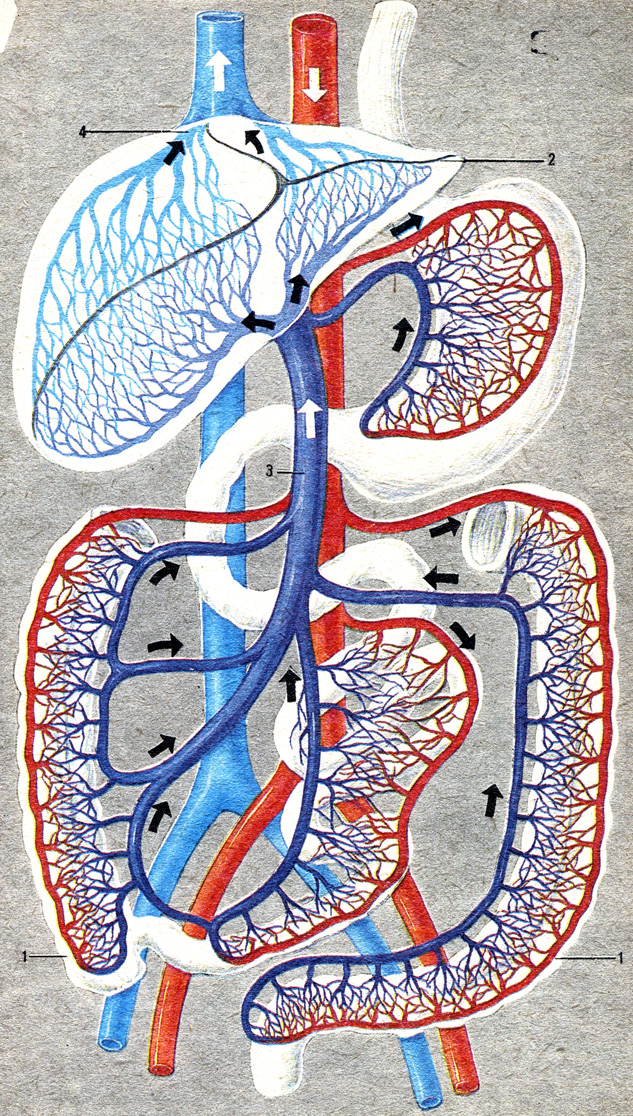
Functions of the large intestine. In the large intestine, stool is formed. Undigested food remains from the small intestine pass through the large intestine for about 12 hours. During this time, most of the water is absorbed into the blood from its semi-liquid contents. The feces formed in the large intestine enter the rectum, and from there they are removed to the outside.
■ Bile. pancreatic juice. intestinal juice. Villi of the small intestine. Barrier role of the liver.
? 1. What end products of nutrient breakdown are formed in the small intestine? 2. Where are the end products of the breakdown of proteins and carbohydrates absorbed? 3. Where does the formation of fats characteristic of the human body occur? 4. Where do the formed fats go? 5. What processes take place in the large intestine?
! 1. With some serious diseases of the stomach, it is necessary to remove most of it. Digestion of what substances is difficult in operated patients? 2. Why does the breakdown of these substances still occur in their digestive system?







